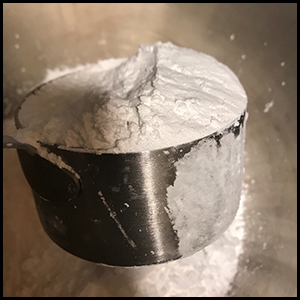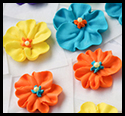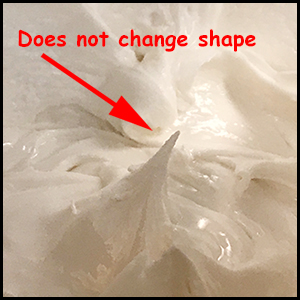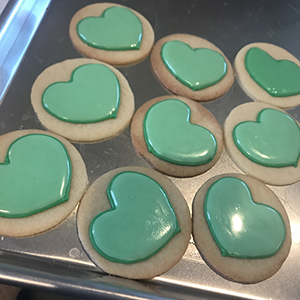Royal Icing Recipes (update 8/9/19)
Royal Icing primarily consists of egg whites whipped with powdered sugar, plus a little flavoring,. Unfortunately, recipe directions very greatly as do ingredients which can include raw egg whites, pasteurized egg whites, or dry, meringue powder.
I began making Royal Icing in late 2017 and was disappointed with the results. By mid-2018, I began testing a number of recipes and believe that the one I reproduced here is foolproof.
This recipe contains pasteurized egg whites, fine (10x) powdered sugar, and a touch of flavoring. It dries to a smooth surface, does not bubble under the surface as it dries, does not pit at piping junctures, is easy to flow, and is not dull.
Recipe for a Very Firm Royal Icing
Ingredients:
2 pounds of fine (**10x) powdered sugar or 8 rounded cups of powdered sugar
11 tablespoons (5.5 ounces) of pasteurized egg whites (you’ll find this product where eggs are sold)
2 “slight” teaspoons of flavoring, to taste
Instructions:
There is no order for mixing the ingredients. Simply put them all into a bowl at the same time, then turn your heavy-duty mixer on, using an easy-to-clean paddle beater.
Detail: Start on a low speed so that dry ingredients don’t fly about. Increase the speed to high until everything is pure white. Scrape so there is no loose powdered sugar left on the sides or bottom of your bowl.
There is no exact recipe for making Royal Icing, however, if you prefer to be exacting, measure ingredients by weight.
There is a wide margin for success no matter how much powdered sugar you add with the consistency you need being dictated by the decorating task at hand. This ranges from flow (more liquid) to a very very stiff consistency required for piping shapes, like flowers (more powdered sugar).
Below is a “rounded cup” of powdered sugar you can use for the initial batch.
Objectives:
The consistency (thickness) of the resulting icing depends on humidity in your environment, which adds moisture to your mixture, and the amount of moisture supplied by the egg whites.
The firmer the initial batch of Royal Icing, the better, as the icing can be thinned for a variety of your needs without adding more powdered sugar.
An extremely stiff consistency is used for making structures, like Royal Icing flowers. For more examples than the picture below, check out those made by the Barefoot Baker’s tutorial.
To identify a stiff consistency, stir the batch with a beater or spoon. When you lift the beater up, peaks form that do not bend or change shape. If the frosting flattens or blends even a little bit, it is not truly “stiff.”
A very thick consistency, however, displays a very minor amount of blending and is good for most tasks as it can also be thinned.
To identify a very thick consistency, stir the batch with a beater or spoon. When you lift the beater up, icing peaks form that very, very slowly bend over and eventually sink into a flat surface.
Adjustments are made to portions of the initial batch as your needs dictate.
To increase the stiffness of a portion, add more powdered sugar, a little at a time.
To decrease (moisten) the stiffness of a portion, add water, a little at a time. I recommend you use a glass, food-grade spray bottle to add small amounts of water and not measuring spoons.
Light Corn Syrup:
The addition of light corn syrup to a portion produces a more pliable, elastic mixture that dries to a sheen, like in the photo that follows:
Batches without light corn syrup tend to have a dull surface, like the cookie below:
Light corn syrup is a liquid, so adding it to a portion has almost the same effect as adding water. Blogs by famed pastry implement manufacturer, Wilton, for example, suggest using light corn syrup instead of water to thin Royal Icing. Measurement is a matter of observation based on your consistency needs.
Whether water or a combination of water and light corn syrup, be careful to add it in small amounts because to repair a batch, sometimes a significant amount of additional powdered sugar is required.
I currently use light corn syrup almost exclusively, followed as needed by only a “touch” of water. Corn syrup can be added to an extremely stiff consistency to give the results a sheen, but you run the risk of making your batch too soft to hold shapes.
Eyeball Measurement:
The most foolproof recipe for Royal Icing is the one posted here. When working with it, however, it is up to you to observe its behavior based on your needs.
Flow consistency should not be so moist that it overflows borders or cookie edges.
Piping consistency should not be so dry that you can’t get it through your piping tip, or when you can get it through your tip, not so dry that the extrusion breaks, bunches up, rides up the side of your piping tip, or hurts your hand from squeezing the piping bag.
Extremely stiff or flower development consistency must be dry enough to hold piped shapes, yet moist enough to go through your piping tip. Experiment by adding small amounts of additional powdered sugar until the shapes you pipe hold their own.
Sifting Powdered Sugar:
I have not found it necessary to sift 10X powdered sugar for the recipe I recommend. Even dried bits of powdered sugar will re-moisturize when stirred back into a batch.
I do not use very fine tips. PME #00, or #0, for example, can get clogged. Clogging most commonly occurs during piping, when you set your piping bag aside and the icing in the tip begins to dry out. Work very quickly with small tips to avoid this problem and consider using a smaller amount in your piping bag, which you’ll frequently change, rather than a lot like you would during a flooding operation where icing must cover broad areas.
If you are worried about lumps in your icing, put the icing through a fine metal strainer before filling a bag.
Storage:
Store the icing in an air-tight container. Consider placing plastic wrap over the icing before snapping the top on the container. It can be kept for days in a refrigerator, although the mixture must be vigorously stirred before reuse.
Mixing
The initial batch of Royal Icing is quite thick and demands a heavy-duty mixer. If you are on a budget, the 300 watt, Hamilton Beach 63325 6-Speed Stand Mixer for under $100 is a good buy.
Drying and storing Royal Icing
- Freshly decorated cookies taste best, with my preference being within three days of being iced. Icing on stored decorated cookies becomes harder and more crispy as they age.
- While crispy icing is pretty, pay attention to the quality of your cookie. Cookies exposed to high humidity become limp, with some softness appearing under the icing.
- Royal Icing can be stored in the refrigerator for several days. Place a plastic covering directly on the icing, then seal the container over that covering with an air-tight lid.
- After applying icing to cookies, the best practice calls for drying the icing under a fan. If the icing dents when pressed, it is not completely dry.
- To keep cookies crisp, store iced cookies in an air tight container with parchment paper between them or in individual, air-tight bags.
- Check to make sure there is no condensation in your container or bag when storing iced cookies in the refrigerator.
- If possible, work in an air conditioned environment. Avoid making Royal Icing or frosting cookies with it when the humidity in your environment is high or not controlled. Check your atmosphere on a digital humidity monitor. Even heated rooms can suffer from high humidity, especially a kitchen.
- Under normal to low humidity days, iced cookies can be left out for a few days, during which period the icing becomes harder. On high humidity days, if the cookies are left out, you will lose the cookies’ crispness and possibly destroy your work.
Links
- Pictorial article by SemiSweet (Mike Tamplin), SemiSweetDesigns.com
- Cookie design master, Julia Usher, www.juliausher.com
- Blueprint, formerly Craftsy, has several excellent fee-based courses on the use of Royal Icing on cookies. I learned from
Better Basics for Exceptional Cookies by Stephanie Kappel. Also excellent are courses by Amber Spiegel. Many of the tutorial instructors here also have websites and YouTube videos.
-
Royal Icing with Consistency Adjustments, blog by Julia Usher, www.juliausher.com
-
Toolbox Talk: Corn Syrup in Royal Icing, research article by member LIESBET on “Toolbox Talk,” a site by Julia Usher, www.juliausher.com
-
Make good use of Google and YouTube searches to find numerous articles and tutorials developed by people excited about skill sharing. Royal Icing Tutorials
- How to make a simple Royal Icing primrose, a tutorial by The Barefoot Baker, thebearfootbaker.com.
Article series
To see a list of all articles in this series, CLICK HERE
**Note: 10X refers to a finely milled powder sugar with cornstarch is added to prevent caking.
Questions? Comments? Additions? Corrections? Write to Karen Little at karen@Littleviews.com
Written for Littleviews-Crafts.com by Karen Little, publisher. All rights reserved, but feel free to re-publish this article after contacting Karen so she knows where to find it.




